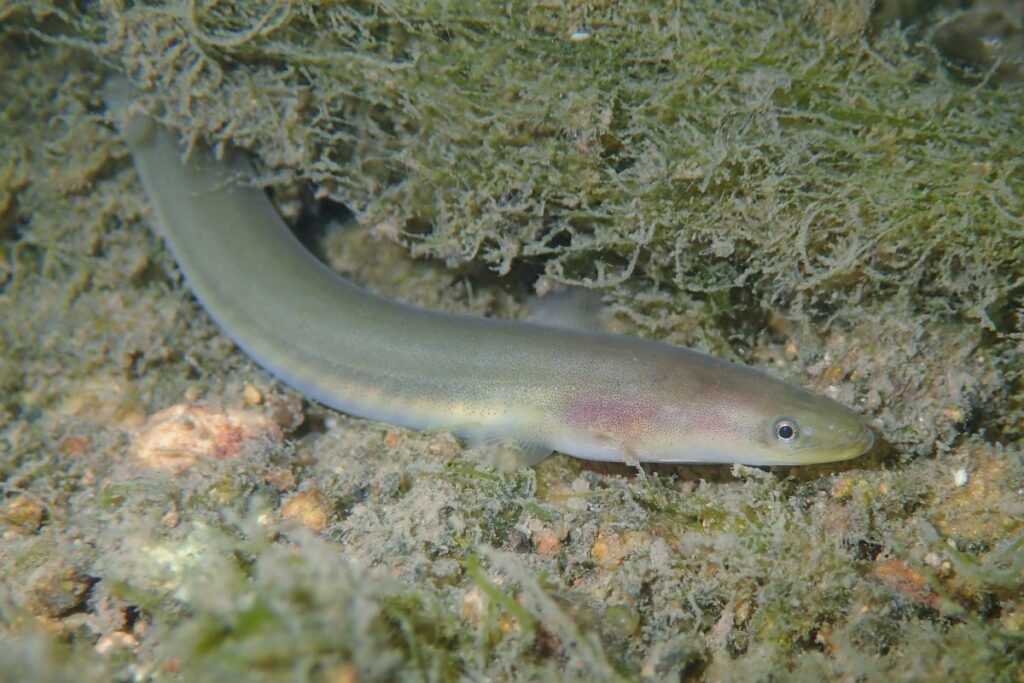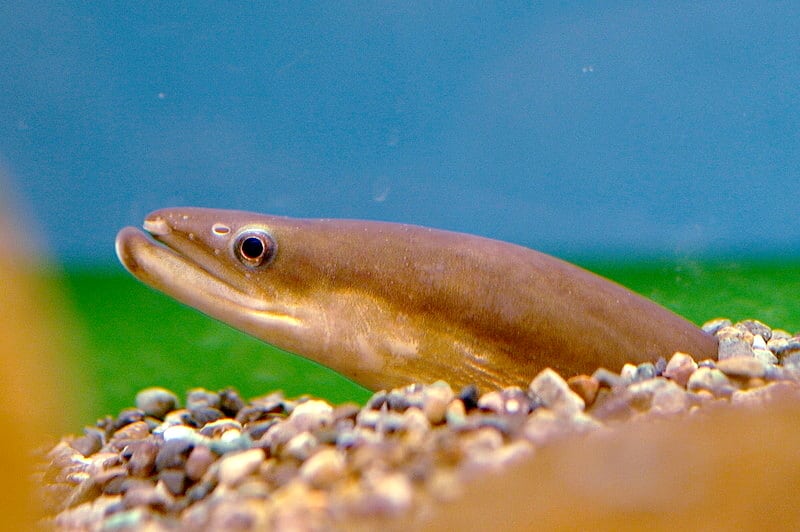Japanese eels are a delicacy in Japan where they were once abundant. Today, their populations dwindle due to overfishing, pollution, and habitat destruction. Farming efforts have tried to bring their populations back up. Still, this is difficult to do because of the Japanese eel’s complex life cycle.

These eels spend most of their lives in freshwater. Yet, they hatch and die in the ocean. Their natural reproductive process makes it very difficult to breed them in captivity.
What Is A Japanese Eel?
- Common Names: Japanese Eel
- Scientific Name: Anguilla japonica
- Origin: Japan, China, Vietnam, the Philippines
- Length: 3.2-4.3 ft (1-1.3 m)
Japanese eels are freshwater eels very similar to American and European eels. These eels are all catadromous. They spend part of their life in saltwater and part of it in freshwater.
For the longest time, the mystery of eel reproduction has eluded researchers. Eels likely existed for about 60 million years. But, it wasn’t until 2009 that researchers discovered where and how their lives begins.
Japanese eels spawn in the ocean. The ocean is often thousands of miles/kilometers from where they normally live. The rest of their lives are spent in freshwater rivers and estuaries.
Life Cycle
Eels lay their eggs thousands of miles/kilometers from freshwater. American eels spawn in the Sargasso Sea. It’s thought that Japanese eels spawn in the north Pacific between three seamounts in the West Mariana Ridge.
The eggs hatch into larvae called “leptocephalus”. The larvae are transparent and shaped like leaves. Once they hatch, they begin migrating from the ocean in search of freshwater. This journey often takes between one and five years.
Eventually, the larvae will approach the mouth of a river or an estuary. They will have transformed into “glass” eels. Glass eels are still transparent, but they will have taken on the elongated shape of an eel.
As they continue traveling towards fresher water, they grow into “elvers”. Elvers are slightly bigger and have become grayish brown in color.
Upon reaching purely fresh water, they grow into “yellow” eels. Yellow eels are technically juveniles, but they spend most of their lives in this stage. Some eels may be in this stage for up to 20 years.
Once the eels become sexually mature, they are “silver” eels. They take on a shiny silvery color, and their stomachs disintegrate as they prepare to head back to sea. They travel thousands of miles/kilometers back to their spawning grounds without eating. They also develop larger eyes that can see better in the dark.
Once the silver eels reach their spawning grounds, they reproduce and immediately die.
Japanese eels reproduce via external fertilization. A single female can produce between 2-10 million eggs. The male then releases his sperm into the water column to fertilize the eggs.
Japanese Eels Are Endangered

According to the International Union for the Conservation of Nature (IUCN), these Japanese freshwater eels are “endangered”.
Their populations are declining due to habitat destruction, overfishing, and pollution. Overfishing is the biggest problem they face. Phys.org says:
“The annual catch in Japan of young known as glass eels has fallen to 10 percent of 1960 levels.”
Mary McMahon from ‘All Things Nature’ says:
“Aquaculture operations for raising the Japanese eel count on trapping larvae or so-called “glass eels,” immature eels getting ready to move into freshwater, because fish farmers have not been able to breed eels in captivity. Some scientists are concerned that aquaculture may be harmful to eel populations, as fish are captured before they have an opportunity to breed and produce more eels. This, combined with harvesting adult eels for the commercial market, may be another reason for the fall in the eel population.”
Because of their dwindling numbers, the Japanese people no longer eat eel as often as they used to. Eel used to be common with nearly every meal, but now it’s a rare delicacy. Since the year 2000, eel meat has about tripled in price.
Some countries have put restrictions and bans on the export of eel. But, that has led to fish sales on the black market.
In 2020, Japan’s Fisheries Agency (JFA) reported that 14 tons of legal glass eels were imported to eel farms. But, the farms reported buying more than 20 tons of eels. So, many of the eels were imported illegally.
The World Wildlife Fund (WWF) of Japan believes that 40-60% of the eels raised in Japan have come from illegal trade.
Conclusion
Japanese eels are beloved across Japan. They were once a common, everyday food. But, as their populations dwindle, they have now become an expensive delicacy.
Like American and European eels, Japanese eels have a complex life cycle. They begin and end their lives in the ocean, but spend most of their lives in freshwater.
FAQs
Yes, unagi is eel. “Unagi” is simply Japanese for eel, generally referring to freshwater eel. “Anago” is the Japanese word for saltwater eel. These terms are most often used when discussing eels as food.
Unagi eel is one of Japan’s favorite foods. The people eat 130,000 tons of eel every single year. Eels have tender white flesh and are full of nutritious vitamins and proteins.
Every year, they celebrate ‘Doyo-ushinohi’, or ‘eel day’. It is the hottest day of the summer. On this day, they celebrate by feasting on eel more than they do any other day of the year.
Today, the Japanese consider eel to be a delicacy. You can find artisanal eel restaurants all over the country. It is not uncommon for people to wait over an hour to receive their meal. The wait is because the eels are usually kept alive until preparation time.
One of the most popular eel dishes is “kabayaki”. The eel is cut open and cut into filets. It is then skewered and dipped in a special soy sauce before it’s grilled. The sauce is usually unique to each individual restaurant and enhances the flavor.
Japanese eels are commonly farmed. Farming helps with their dwindling populations.
It is not common for Japanese eels to be kept as pets, and there isn’t much information on it.
Eels are an important part of Japanese culture. People associate eels with stamina. This is because of the long migratory journeys they make to spawn.
